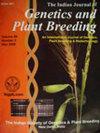Doubled haploid production in maize under Sub-montane Himalayan conditions using R1-nj-based haploid inducer TAILP1
IF 0.8
4区 生物学
Q3 PLANT SCIENCES
引用次数: 1
Abstract
The use of in vivo haploid induction system makes the doubled haploid (DH) technology easier to adopt for the conventional maize breeders. However, despite having played an important role in the initial developmental phases of DH technology, Indian maize research has yet to harvest its benefits. Haploid Inducer Lines (HILs) developed by CIMMYT are being widely used in maize breeding programmes in many countries including India. There, however, is no published information on the efficiency of DH line production using CIMMYT HILs in Indian maize breeding programmes. In the present study, the efficiency of DH production using CIMMYT’s tropically adapted inducer line TAILP1 was investigated with eight source populations including two of sweet corn. The average haploid induction rate (HIR) of TAILP1 was 5.48% with a range of 2.01 to 10.03%. Efficiency of DH production ranged from 0.14 to 1.87% for different source populations with an average of 1.07%. The information generated will be useful for maize breeders intending to use DH technology for accelerated development of completely homozygous lines.利用基于r1 -nj的单倍体诱导剂TAILP1在亚山地喜马拉雅条件下生产双倍单倍体的玉米
利用体内单倍体诱导系统,使双单倍体技术更容易为传统玉米育种者所采用。然而,尽管印度玉米研究在DH技术的初始发展阶段发挥了重要作用,但它尚未收获其效益。CIMMYT开发的单倍体诱导系(HILs)在包括印度在内的许多国家的玉米育种计划中得到广泛应用。然而,没有关于在印度玉米育种计划中使用CIMMYT HILs的DH系生产效率的公开信息。本研究以8个源群体(包括2个甜玉米群体)为研究对象,对CIMMYT热带适应诱导系TAILP1的DH生产效率进行了研究。平均单倍体诱导率(HIR)为5.48%,范围为2.01 ~ 10.03%。不同源群体DH产生效率为0.14% ~ 1.87%,平均为1.07%。所产生的信息将对打算利用DH技术加速开发完全纯合子系的玉米育种者有用。
本文章由计算机程序翻译,如有差异,请以英文原文为准。
求助全文
约1分钟内获得全文
求助全文
来源期刊

Indian Journal of Genetics and Plant Breeding
PLANT SCIENCES-
CiteScore
1.80
自引率
10.00%
发文量
0
审稿时长
6-12 weeks
期刊介绍:
Advance the cause of genetics and plant breeding and to encourage and promote study and research in these disciplines in the service of agriculture; to disseminate the knowledge of genetics and plant breeding; provide facilities for association and conference among students of genetics and plant breeding and for encouragement of close relationship between them and those in the related sciences; advocate policies in the interest of the nation in the field of genetics and plant breeding, and facilitate international cooperation in the field of genetics and plant breeding.
 求助内容:
求助内容: 应助结果提醒方式:
应助结果提醒方式:


